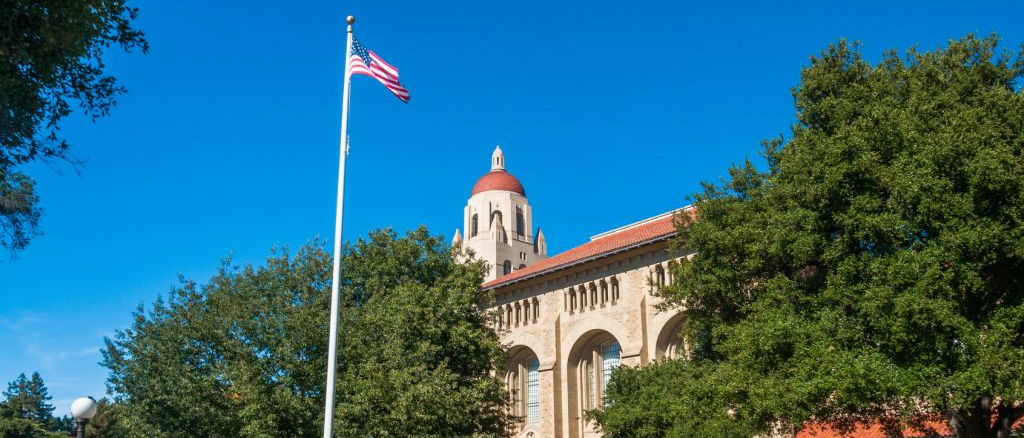IvyWise On-Demand: Stanford University: How to Get in and What to Know
Are you considering applying to Stanford University? Whether you are beginning the college search process or finalizing your list, this is a great opportunity to learn all about the university and hear expert tips on how to get in from IvyWise college admissions counselors Mike, Former Assistant Director of Admissions at Stanford, and Katie at Former Senior Assistant Director of Admissions at MIT.
Watch Now
While Stanford may not technically be part of the Ivy League, the school’s academic caliber — not to mention its competitive admissions process — rivals that of Harvard and Yale. Many students are eager to enroll in the top-tier university, which has a wide array of renowned programs including engineering and environmental science. Although earning admission at Stanford University is challenging, there are a few steps applicants can take to set themselves up for success. Keep reading to learn more about how you can set your application apart.
How to Get into Stanford University: Table of Contents
- When to Apply to Stanford University
- How Hard Is It to Get into Stanford: Early Prep
- How Do You Actually Get into Stanford: The Application
- Class Profile
- What Makes Stanford University Unique?
- Stanford FAQs
When to Apply to Stanford University
Most students apply to Stanford University during fall semester of their senior year for admission the following academic year. However, the deadline for submitting your application depends on whether you choose the early or regular admissions round.
Stanford Deadlines
For first-year applicants, there are two different admissions timelines to choose from: Regular Decision and Restrictive Early Action. The timelines for each are as follows:
It’s important to double-check the deadlines for your admissions cycle, as they may change slightly each year.
Early, Rolling and Regular Decision
As students enter high school, they may start hearing about different application processes, such as Early Action vs rolling admission. While much of the application process will be similar regardless of your timeline, it’s important to understand the distinct differences between early, rolling, and Regular Decision admissions options.
There are two different forms of early admissions: Early Action and Early Decision. The key differentiator between the two is that Early Decision is binding, meaning that if a student applies to a college Early Decision and is accepted, they must enroll. Early Action is not binding. Stanford offers Restrictive Early Action, which stipulates that students cannot apply to any other private college through an early admissions program. Most early application deadlines are in the beginning of November, with decisions released approximately in early to mid-December
In contrast, rolling admissions do not follow a strict deadline. Most schools that offer a rolling admissions (RA) option accept applicants from September through May. It is best to submit your application as early as possible because RA schools only accept students until they reach their enrollment capacity. Stanford University does not offer rolling admissions.
Finally, universities offer a Regular Decision (RD) admissions option. Students who apply RD generally need to submit their applications by early January and learn of their admissions results in April. Stanford University does offer Regular Decision.
Waitlisted Applications
Given how competitive it is to get into the university, it’s not surprising that students are often waitlisted during the Regular Decision round. The Stanford waitlist is composed of exceptionally strong applicants that Stanford simply had no room to admit. Waitlisted students have the option to choose whether they wish to remain on the waitlist; however, the likelihood of being admitted from the waitlist is typically low at most universities.
Deferrals
Students who apply Restrictive Early Action cannot be waitlisted but may be deferred. A deferral means that a student’s application will be considered during the Regular Decision round. It’s helpful to know what to do if you have been deferred. Stanford will provide you with a form to submit any updates, such as fall semester senior year grades, since you submitted your application.
How Hard Is It to Get into Stanford: Early Prep
Stanford University is one of the most prestigious colleges in the country. Every year, thousands of students apply and only a small percentage of them are offered a seat in Stanford’s incoming class.
- Class of 2026: 3.68%
- Class of 2027: 3.91%
- Class of 2028: 3.61%
While admission to Stanford is notoriously competitive, students can increase their chances of admission by preparing well in advance and doing their research to become experts on the school.
Build Your Profile
Like most colleges, Stanford University uses a holistic review process to evaluate applicants. This means that each piece of an application is part of an integrated and comprehensive whole. The primary criteria for admission is academic excellence, meaning Stanford is looking for students who challenge themselves, demonstrate intellectual curiosity, and are committed to expanding their horizons. According to the university’s website, a student’s high school transcript is the most important credential that they use to evaluate an applicant’s academic history.
In addition to academic excellence, the school names extracurricular activities as another important consideration in its admissions process. The Stanford website notes: “an exceptional depth of experience in one or two activities may demonstrate your passion more than minimal participation in five or six clubs. You may also hold down a job or have family responsibilities. These are as important as any other extracurricular activity.”
Visit the Campus and a Class
If you’re eager to attend, visiting the Stanford campus is a smart move. Registering for a campus tour is a powerful way to familiarize yourself with the school. Stanford offers various options to see the campus in person, including student-led tours (with or without an information session) and self-guided tours. Stanford also provides virtual tours and information sessions for those who are unable to visit campus in person.
Connect with a Student
In addition to touring the campus, you have an opportunity to get students’ perspectives on their experience at Stanford University. Stanford offers a Student Forum, which allows prospective students to chat with current undergraduates about dorm life, academics, housing and dining, campus life, and more. Student Forums are offered both on-campus and virtually.
Learn About Any Student Experiences
While the Student Forum is a great opportunity to speak directly to current students, there are other ways to learn about student experiences. The Stanford Daily is a student-run paper that covers a variety of stories around campus. Social media is another great way to learn more about student experiences at Stanford.
How Do You Actually Get into Stanford: The Application
Unfortunately, there’s no secret formula for how to get into Stanford University. However, there are a few key qualities that admissions officers look for when reviewing applications.
GPA Requirements
Stanford University doesn’t specify a minimum high school GPA for admission. However, academic excellence carries the most weight in the Stanford admissions process. For the class of 2028, the average GPA was 3.94. Stanford also values academic rigor, so it’s important to challenge yourself by taking the most advanced and rigorous courses available to you in high school.
SAT and ACT Scores
Stanford reinstated testing requirements for the 2025-26 admissions cycle. So, what is a good SAT or ACT score for Stanford? Data from the 2024-25 Common Data Set shows that of the students who submitted test scores for fall 2024 admission, the middle 50% had a score range of 1,510-1,570 on the SAT and 34-35 on the ACT.
Personal Statement
The personal statement is a chance to show your writing skills and the qualities that set you apart from other applicants. You can choose from seven Common App essay prompts, which gives you the flexibility to write on a topic that you feel is most impactful. Instead of worrying about what you “should” sound like, it’s best to focus on letting your authentic voice and unique personality shine through.
Essays
In addition to the Common App essay prompts, there are three Stanford supplemental essays the admissions officers use to learn more about your interests and the role you would play on campus. Each response must be between 100 and 250 words. Your passion for attending Stanford should shine through in each response. You can do this by referencing specific details like classes you wish to take and professors that you would be excited to study with.
Letters of Recommendation
Stanford University asks for two letters of recommendation from teachers. Teacher recommendations should highlight your love of learning and the impact you have on the classroom. Since most teachers will get an influx of requests for letters of recommendation, aim to ask your instructors by the end of your junior year so that they have plenty of time to draft their responses.
Stanford also allows an optional letter of recommendation from another source of your choice. As a third letter is not required, you should only submit one if you have someone who can provide a level of insight not seen elsewhere in your application. Don’t forget to give your recommenders a copy of your resume and a few talking points that outline your achievements to help them get started.
Admission Interviews
Applicants also have the opportunity to participate in Stanford’s optional admissions interviews with recent alumni. These interviews are informational, rather than evaluative, allowing applicants to demonstrate their interest in attending the college. Practice responding to various interview prompts and come prepared with your own list of questions for your Stanford alumni interviewer.
Contribution to the Stanford Community
Stanford University admissions officers are eager to admit applicants who will make a lasting impact on the Stanford community. Throughout every component of your application process, including supplemental essays and admissions interviews, highlight your goals and the role you would take on once enrolled at Stanford University. Don’t shy away from specific details — it’s best to name specific clubs at Stanford you wish to join, classes you’re excited to take, professors you are eager to work with, and research opportunities you are enthusiastic to take part in.
Class Profile
You’re probably wondering how many people apply to Stanford? The university received 57,326 applications for the class of 2028 and admitted 2,067.
What Makes Stanford University Unique?
First and foremost, the university is known for its renowned academic programs. There are 66 majors at Stanford, ranging from aeronautics and astronautics to urban studies.
Additionally, Stanford has a breadth of clubs and extracurricular activities for students to get involved beyond academics. Noteworthy clubs include The Ram’s Head Theatrical Society, the university’s oldest and largest theatrical society, dating back to 1911. The Stanford Mendicants, an a cappella group formed in 1963, is another popular group.
Students who are passionate about sports will also feel at home at Stanford since the university has produced athletes who have won a combined 296 Olympic medals. Famous alumni include John McEnroe, Tiger Woods, and Julie Foudy. For students looking for a more recreational level of athletics, Stanford also offers many intramural and open rec options, including volleyball, soccer, softball, badminton, and pickleball.
There’s no shortage of landmarks and libraries for students to explore. The Stanford campus has more than 24 libraries and must-see museums like the Cantor Arts Center — which features the Rodin Sculpture Garden — the Anderson Collection at Stanford University, and the Papua New Guinea Sculpture Garden.
Whether you’re passionate about the arts or an aspiring engineer, Stanford is the right fit for students who are driven, ambitious, and committed to giving their passions their all. As the Stanford website suggests, students who will thrive at Stanford are those that are intellectually curious, committed to deepening their expertise in the fields they are passionate about, and determined to make a lasting impact on their communities.
Stanford FAQs
What is Stanford’s admission rate?
Stanford’s admission rate has been below 4% in recent years, making it one of the most selective institutions in the U.S.
What does Stanford look for?
Stanford looks for distinguished academic achievement, intellectual vitality, and significant potential to contribute to the community. They also value leadership and sustained involvement outside the classroom.
Does Stanford require standardized tests?
Beginning with the 2025–26 application cycle, Stanford will reinstate its standardized testing requirement (ACT or SAT scores).
What are the application deadlines?
For first-year applicants, Restrictive Early Action is typically November 1st, and Regular Decision is January 5th. Students submitting art portfolios have earlier deadlines. Check Stanford’s undergraduate admission website for more information.
Admission Counseling
All students and their families can benefit from college admissions counseling. This is especially true if they’re interested in gaining admission to a top-tier college like Stanford University. Working with an admissions counselor gives students the opportunity to receive personalized guidance throughout every step of the application process, including compiling a balanced college list and making the most of campus tours.
Before committing to the invaluable experience of working with a college admissions counselor, it’s important to assess whether you’re ready to give the admissions process your all. Students need to be engaged in the process and excited about their academic future in order to make the most of college counseling. It’s also important to select a college admissions counselor who is accredited, qualified, and has ample admissions experience. Do plenty of research to pick an admissions counselor who brings out the best in you.
It can be tough to gain admission to Stanford University, but IvyWise admission experts are here to help. Take the first step toward getting into your dream school and schedule an Initial Consultation.[
Contact Us



